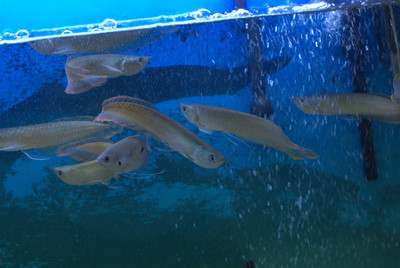Silver Arowana
Posted by Max Gandara on on 19th Sep 2023
The Silver Arowana, scientifically known as Osteoglossum bicirrhosum, is
a captivating and enigmatic fish species that has captured the
fascination of aquarists and nature enthusiasts alike for generations.
This remarkable freshwater fish, often referred to as the "Dragon Fish"
or "Water Monkey," hails from the tropical waters of South America,
primarily the Amazon River basin. In this article, we will delve into
the world of the Silver Arowana, exploring its unique characteristics,
care requirements, and the conservation efforts necessary to protect
this extraordinary species.
The Silver Arowana boasts a sleek and elongated body, characterized by
large scales that shimmer like silver armor under the right lighting
conditions. It has a pair of barbels on its lower jaw, resembling the
whiskers of a catfish, which it uses to sense prey and navigate in its
environment. One of the most distinctive features of the Arowana is its
long, slender body, which gives it an elegant and almost dragon-like
appearance. Adult specimens can reach impressive lengths of up to three
feet (90 cm) or even more.
Silver Arowanas have powerful pectoral fins that allow them to glide
gracefully on the water's surface, much like a dragon skimming the
skies. Their dorsal fin is located far back on their body, almost near
the tail, which provides stability during these surface journeys. This
unique adaptation makes them exceptional jumpers, as they are known to
leap out of the water to capture insects and other prey.
The natural habitat of the Silver Arowana is the slow-moving, heavily
vegetated waters of the Amazon River and its tributaries, which are
typically stained with tannins from decaying leaves and organic matter.
These waters are densely populated with various species of fish,
insects, and other aquatic life, providing an abundant source of food
for the Arowana.
In the wild, Silver Arowanas are primarily found in regions with
submerged tree roots and overhanging vegetation. They use their
exceptional jumping abilities to catch prey, such as insects, small
birds, and even smaller fish, by ambushing them from below or leaping
out of the water to snatch them from low-hanging branches.
Keeping a Silver Arowana in captivity can be a rewarding but challenging
endeavor. These fish require a spacious aquarium due to their large
size and natural behavior of swimming near the water's surface. A tank
with a minimum capacity of 250 gallons is recommended for adult
Arowanas, and it should be equipped with a tight-fitting lid to prevent
them from jumping out.
Water quality is crucial for their well-being. Arowanas thrive in
slightly acidic to neutral water conditions with a pH level ranging from
6.0 to 7.0. Regular water changes and a powerful filtration system are
essential to maintain water quality. Additionally, a strong heater is
needed to maintain a stable water temperature between 75-82°F (24-28°C).
Feeding Silver Arowanas is relatively straightforward. They are
carnivorous predators that primarily feed on live or frozen food items
such as fish, shrimp, insects, and even small mammals in the wild. In
captivity, a diet of high-quality pellets, frozen food, and occasional
live treats will suffice.
The Silver Arowana faces numerous threats in the wild, including habitat
destruction, overfishing for the aquarium trade, and water pollution.
Conservation efforts are vital to protect this species and preserve its
natural habitat.
Protecting the Amazon rainforest, where Arowanas reside, is a
significant step in their conservation. Sustainable harvesting practices
and regulations on the international trade of Silver Arowanas are also
necessary to prevent their decline in the wild.
The Silver Arowana, with its stunning appearance and unique behavior, is
a truly captivating freshwater fish that has earned a special place in
the hearts of aquarists and nature enthusiasts. While challenging to
care for in captivity, the rewards of witnessing their graceful
movements and extraordinary leaping abilities are unparalleled. As we
admire and cherish these majestic creatures, let us also recognize the
importance of their conservation to ensure they continue to grace our
world with their presence for generations to come.

